Application of Leadership
VerifiedAdded on 2023/01/04
|13
|3074
|39
AI Summary
This document discusses the application of leadership in teamwork, focusing on the Agrodome Company. It explores the relationship between leadership and teamwork, theories of teamwork and leadership, the importance of motivation, and internal and external factors affecting leadership and teamwork. The document provides valuable insights for understanding and implementing effective leadership strategies in organizations.
Contribute Materials
Your contribution can guide someone’s learning journey. Share your
documents today.
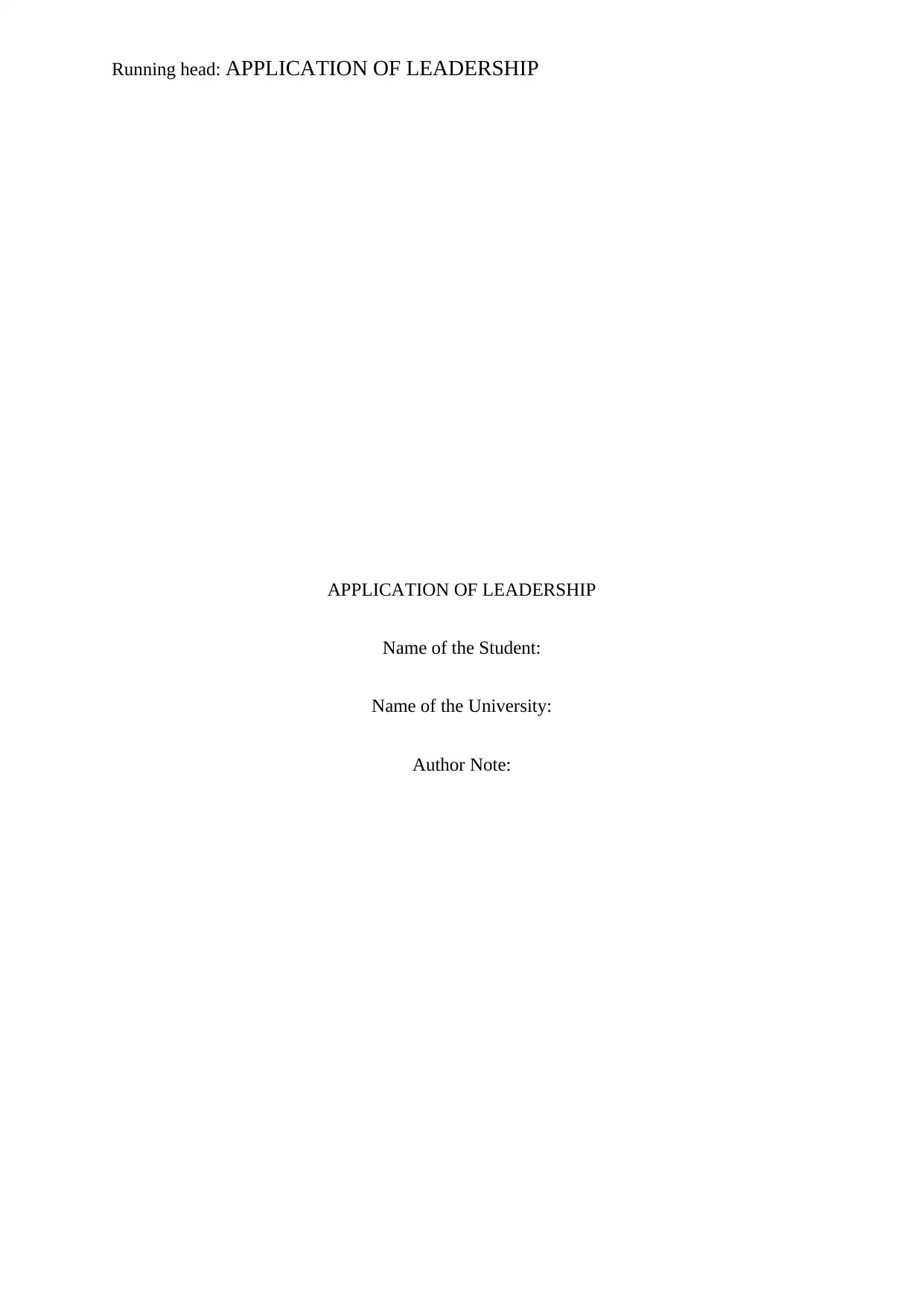
Running head: APPLICATION OF LEADERSHIP
APPLICATION OF LEADERSHIP
Name of the Student:
Name of the University:
Author Note:
APPLICATION OF LEADERSHIP
Name of the Student:
Name of the University:
Author Note:
Secure Best Marks with AI Grader
Need help grading? Try our AI Grader for instant feedback on your assignments.
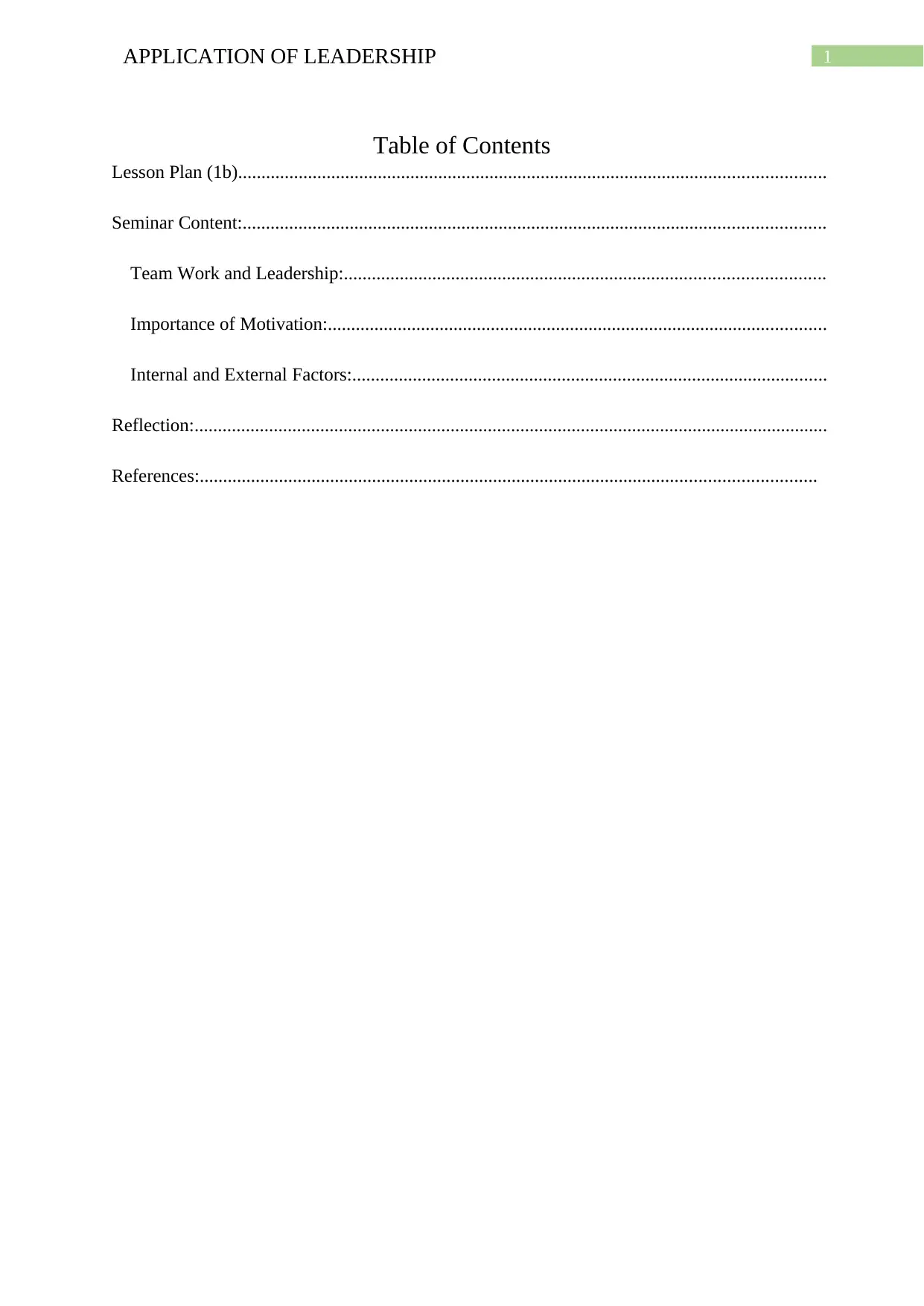
1APPLICATION OF LEADERSHIP
Table of Contents
Lesson Plan (1b)..............................................................................................................................
Seminar Content:.............................................................................................................................
Team Work and Leadership:.......................................................................................................
Importance of Motivation:...........................................................................................................
Internal and External Factors:......................................................................................................
Reflection:........................................................................................................................................
References:....................................................................................................................................
Table of Contents
Lesson Plan (1b)..............................................................................................................................
Seminar Content:.............................................................................................................................
Team Work and Leadership:.......................................................................................................
Importance of Motivation:...........................................................................................................
Internal and External Factors:......................................................................................................
Reflection:........................................................................................................................................
References:....................................................................................................................................
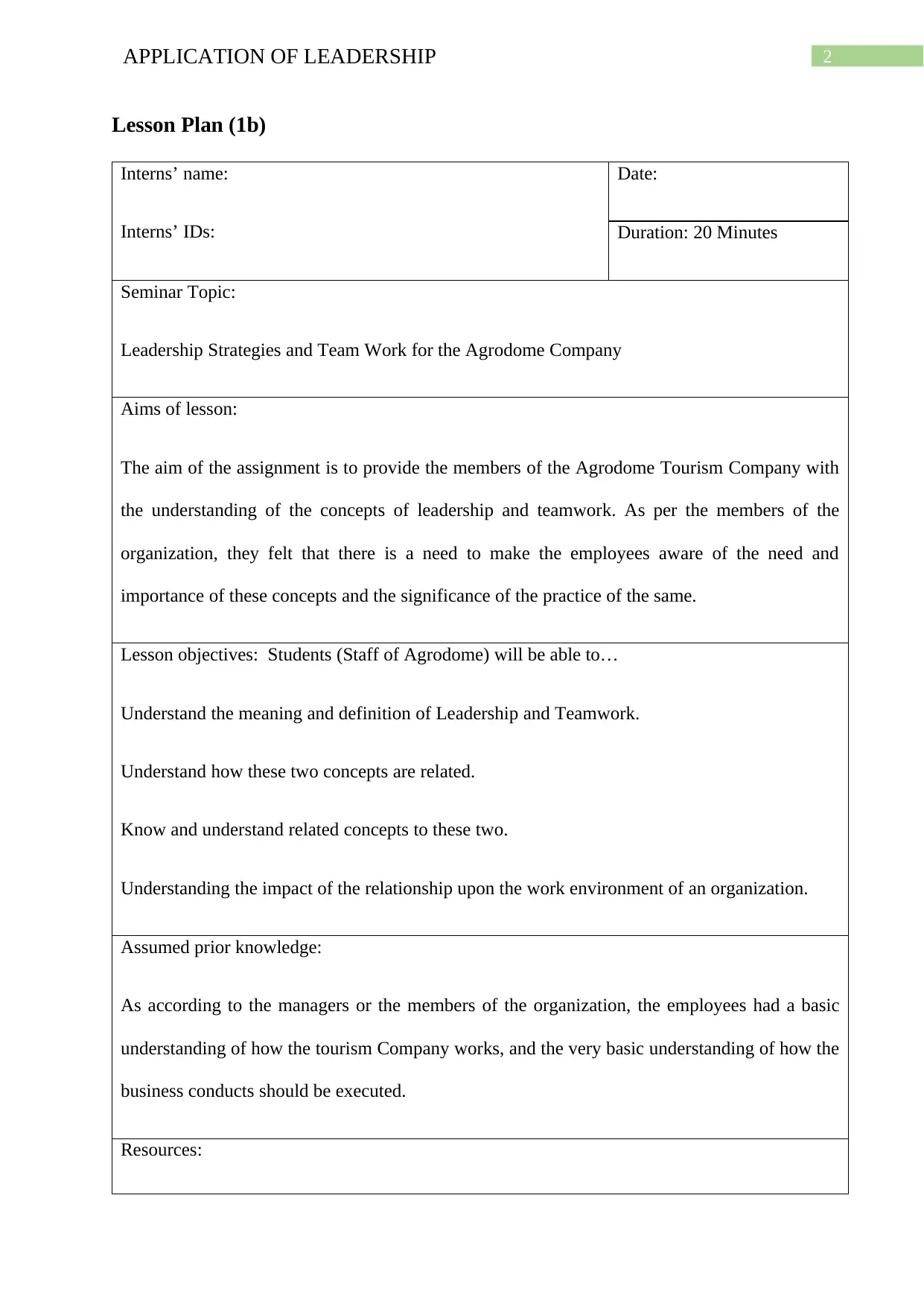
2APPLICATION OF LEADERSHIP
Lesson Plan (1b)
Interns’ name:
Interns’ IDs:
Date:
Duration: 20 Minutes
Seminar Topic:
Leadership Strategies and Team Work for the Agrodome Company
Aims of lesson:
The aim of the assignment is to provide the members of the Agrodome Tourism Company with
the understanding of the concepts of leadership and teamwork. As per the members of the
organization, they felt that there is a need to make the employees aware of the need and
importance of these concepts and the significance of the practice of the same.
Lesson objectives: Students (Staff of Agrodome) will be able to…
Understand the meaning and definition of Leadership and Teamwork.
Understand how these two concepts are related.
Know and understand related concepts to these two.
Understanding the impact of the relationship upon the work environment of an organization.
Assumed prior knowledge:
As according to the managers or the members of the organization, the employees had a basic
understanding of how the tourism Company works, and the very basic understanding of how the
business conducts should be executed.
Resources:
Lesson Plan (1b)
Interns’ name:
Interns’ IDs:
Date:
Duration: 20 Minutes
Seminar Topic:
Leadership Strategies and Team Work for the Agrodome Company
Aims of lesson:
The aim of the assignment is to provide the members of the Agrodome Tourism Company with
the understanding of the concepts of leadership and teamwork. As per the members of the
organization, they felt that there is a need to make the employees aware of the need and
importance of these concepts and the significance of the practice of the same.
Lesson objectives: Students (Staff of Agrodome) will be able to…
Understand the meaning and definition of Leadership and Teamwork.
Understand how these two concepts are related.
Know and understand related concepts to these two.
Understanding the impact of the relationship upon the work environment of an organization.
Assumed prior knowledge:
As according to the managers or the members of the organization, the employees had a basic
understanding of how the tourism Company works, and the very basic understanding of how the
business conducts should be executed.
Resources:
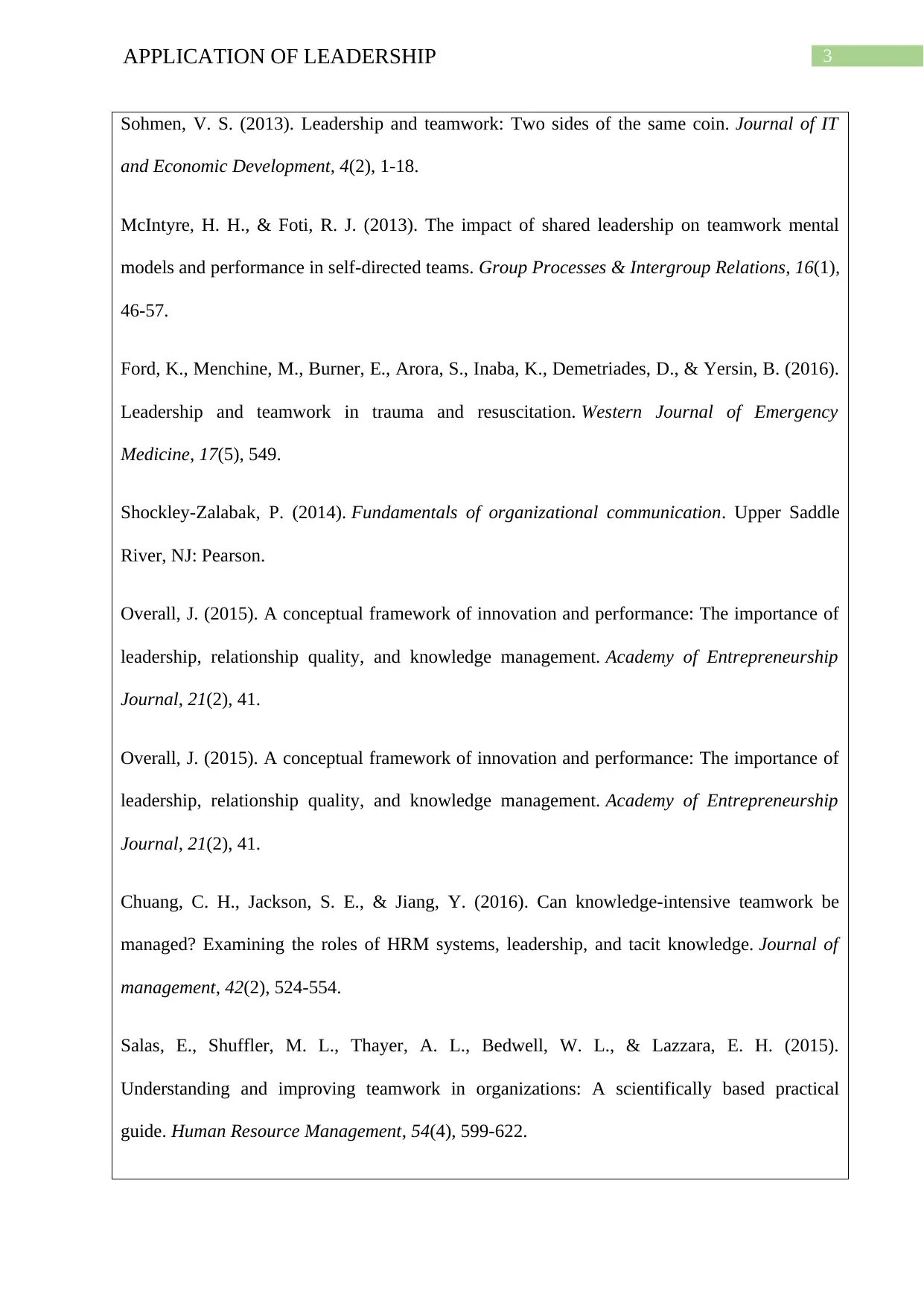
3APPLICATION OF LEADERSHIP
Sohmen, V. S. (2013). Leadership and teamwork: Two sides of the same coin. Journal of IT
and Economic Development, 4(2), 1-18.
McIntyre, H. H., & Foti, R. J. (2013). The impact of shared leadership on teamwork mental
models and performance in self-directed teams. Group Processes & Intergroup Relations, 16(1),
46-57.
Ford, K., Menchine, M., Burner, E., Arora, S., Inaba, K., Demetriades, D., & Yersin, B. (2016).
Leadership and teamwork in trauma and resuscitation. Western Journal of Emergency
Medicine, 17(5), 549.
Shockley-Zalabak, P. (2014). Fundamentals of organizational communication. Upper Saddle
River, NJ: Pearson.
Overall, J. (2015). A conceptual framework of innovation and performance: The importance of
leadership, relationship quality, and knowledge management. Academy of Entrepreneurship
Journal, 21(2), 41.
Overall, J. (2015). A conceptual framework of innovation and performance: The importance of
leadership, relationship quality, and knowledge management. Academy of Entrepreneurship
Journal, 21(2), 41.
Chuang, C. H., Jackson, S. E., & Jiang, Y. (2016). Can knowledge-intensive teamwork be
managed? Examining the roles of HRM systems, leadership, and tacit knowledge. Journal of
management, 42(2), 524-554.
Salas, E., Shuffler, M. L., Thayer, A. L., Bedwell, W. L., & Lazzara, E. H. (2015).
Understanding and improving teamwork in organizations: A scientifically based practical
guide. Human Resource Management, 54(4), 599-622.
Sohmen, V. S. (2013). Leadership and teamwork: Two sides of the same coin. Journal of IT
and Economic Development, 4(2), 1-18.
McIntyre, H. H., & Foti, R. J. (2013). The impact of shared leadership on teamwork mental
models and performance in self-directed teams. Group Processes & Intergroup Relations, 16(1),
46-57.
Ford, K., Menchine, M., Burner, E., Arora, S., Inaba, K., Demetriades, D., & Yersin, B. (2016).
Leadership and teamwork in trauma and resuscitation. Western Journal of Emergency
Medicine, 17(5), 549.
Shockley-Zalabak, P. (2014). Fundamentals of organizational communication. Upper Saddle
River, NJ: Pearson.
Overall, J. (2015). A conceptual framework of innovation and performance: The importance of
leadership, relationship quality, and knowledge management. Academy of Entrepreneurship
Journal, 21(2), 41.
Overall, J. (2015). A conceptual framework of innovation and performance: The importance of
leadership, relationship quality, and knowledge management. Academy of Entrepreneurship
Journal, 21(2), 41.
Chuang, C. H., Jackson, S. E., & Jiang, Y. (2016). Can knowledge-intensive teamwork be
managed? Examining the roles of HRM systems, leadership, and tacit knowledge. Journal of
management, 42(2), 524-554.
Salas, E., Shuffler, M. L., Thayer, A. L., Bedwell, W. L., & Lazzara, E. H. (2015).
Understanding and improving teamwork in organizations: A scientifically based practical
guide. Human Resource Management, 54(4), 599-622.
Secure Best Marks with AI Grader
Need help grading? Try our AI Grader for instant feedback on your assignments.
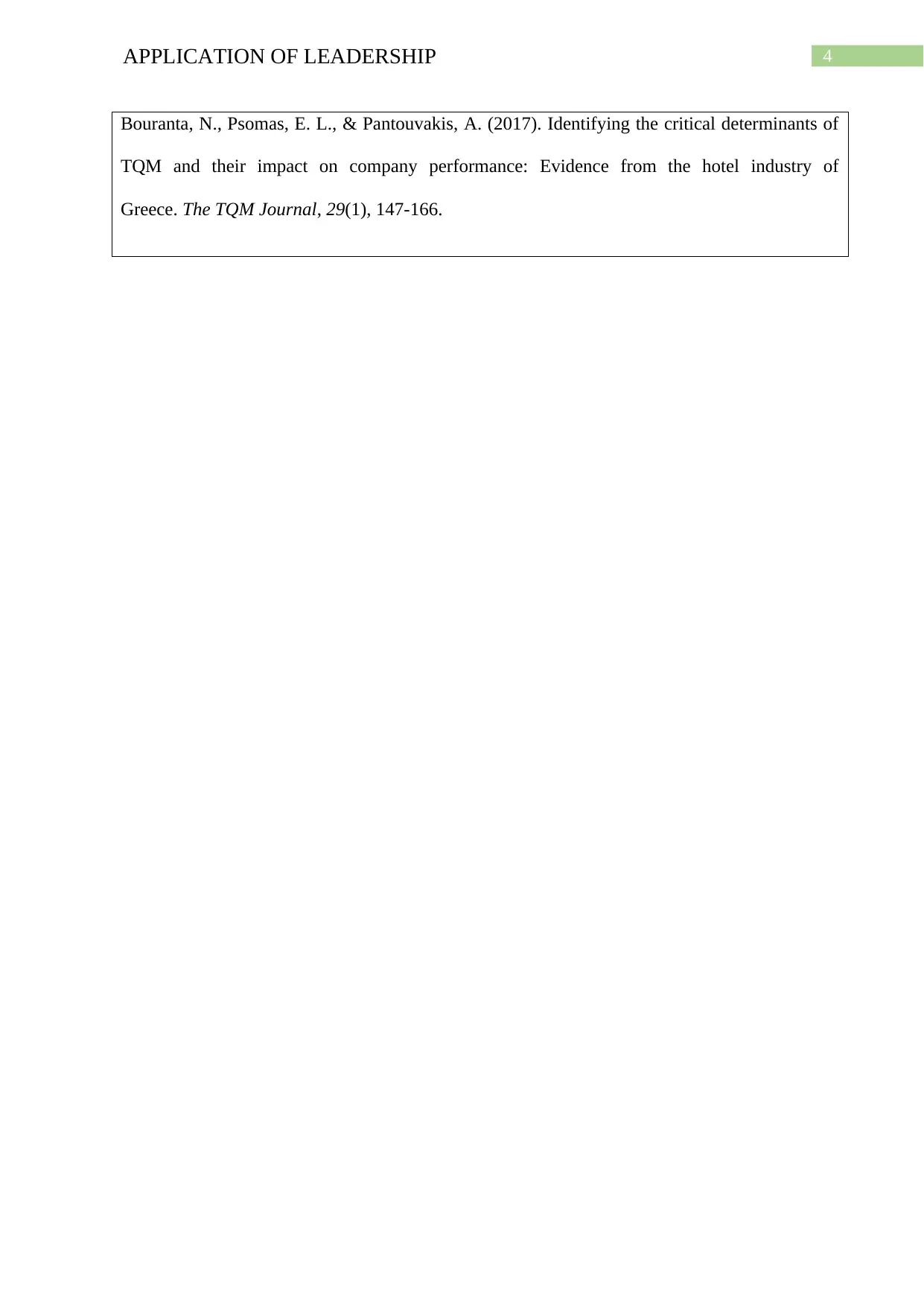
4APPLICATION OF LEADERSHIP
Bouranta, N., Psomas, E. L., & Pantouvakis, A. (2017). Identifying the critical determinants of
TQM and their impact on company performance: Evidence from the hotel industry of
Greece. The TQM Journal, 29(1), 147-166.
Bouranta, N., Psomas, E. L., & Pantouvakis, A. (2017). Identifying the critical determinants of
TQM and their impact on company performance: Evidence from the hotel industry of
Greece. The TQM Journal, 29(1), 147-166.
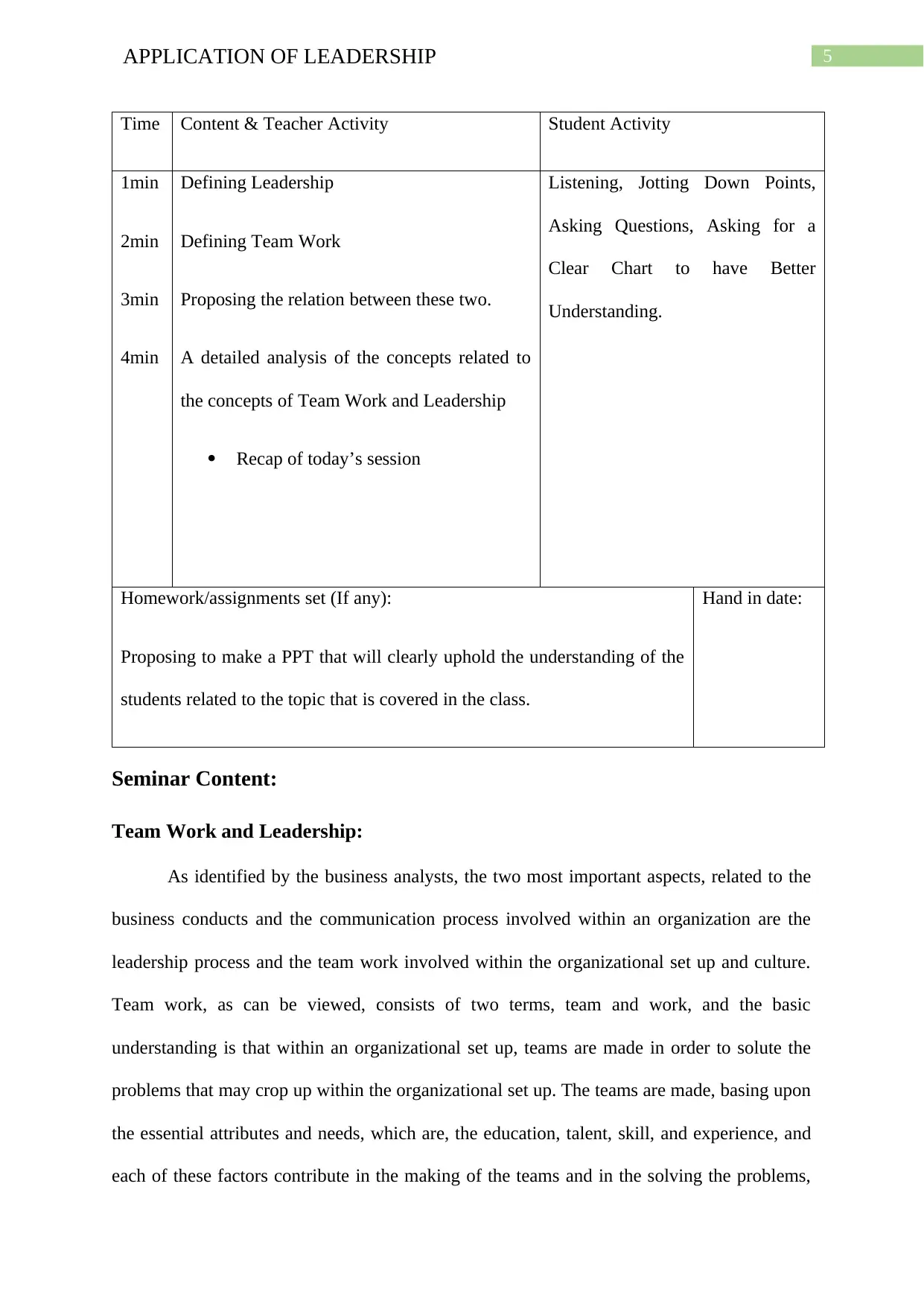
5APPLICATION OF LEADERSHIP
Time Content & Teacher Activity Student Activity
1min
2min
3min
4min
Defining Leadership
Defining Team Work
Proposing the relation between these two.
A detailed analysis of the concepts related to
the concepts of Team Work and Leadership
Recap of today’s session
Listening, Jotting Down Points,
Asking Questions, Asking for a
Clear Chart to have Better
Understanding.
Homework/assignments set (If any):
Proposing to make a PPT that will clearly uphold the understanding of the
students related to the topic that is covered in the class.
Hand in date:
Seminar Content:
Team Work and Leadership:
As identified by the business analysts, the two most important aspects, related to the
business conducts and the communication process involved within an organization are the
leadership process and the team work involved within the organizational set up and culture.
Team work, as can be viewed, consists of two terms, team and work, and the basic
understanding is that within an organizational set up, teams are made in order to solute the
problems that may crop up within the organizational set up. The teams are made, basing upon
the essential attributes and needs, which are, the education, talent, skill, and experience, and
each of these factors contribute in the making of the teams and in the solving the problems,
Time Content & Teacher Activity Student Activity
1min
2min
3min
4min
Defining Leadership
Defining Team Work
Proposing the relation between these two.
A detailed analysis of the concepts related to
the concepts of Team Work and Leadership
Recap of today’s session
Listening, Jotting Down Points,
Asking Questions, Asking for a
Clear Chart to have Better
Understanding.
Homework/assignments set (If any):
Proposing to make a PPT that will clearly uphold the understanding of the
students related to the topic that is covered in the class.
Hand in date:
Seminar Content:
Team Work and Leadership:
As identified by the business analysts, the two most important aspects, related to the
business conducts and the communication process involved within an organization are the
leadership process and the team work involved within the organizational set up and culture.
Team work, as can be viewed, consists of two terms, team and work, and the basic
understanding is that within an organizational set up, teams are made in order to solute the
problems that may crop up within the organizational set up. The teams are made, basing upon
the essential attributes and needs, which are, the education, talent, skill, and experience, and
each of these factors contribute in the making of the teams and in the solving the problems,
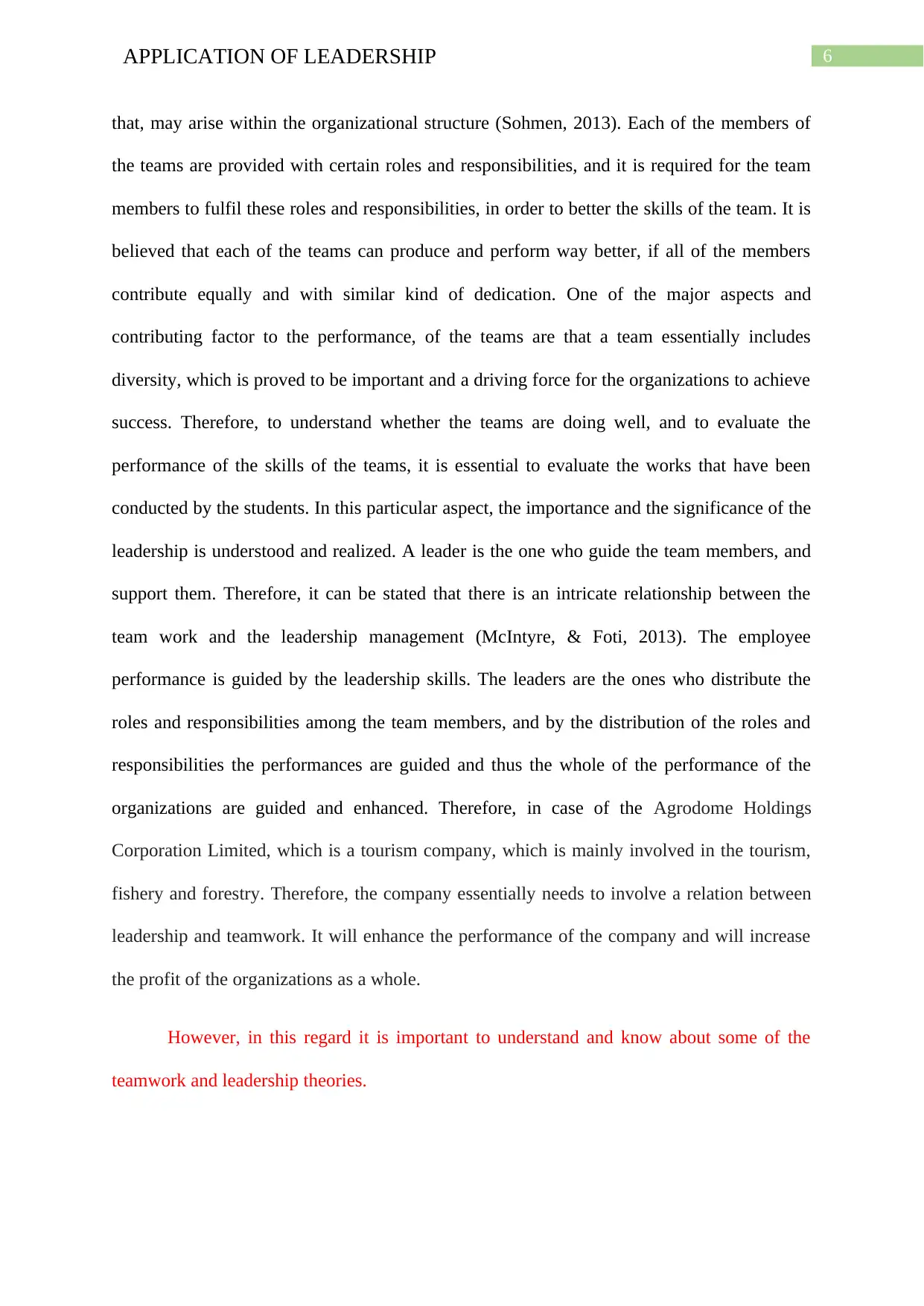
6APPLICATION OF LEADERSHIP
that, may arise within the organizational structure (Sohmen, 2013). Each of the members of
the teams are provided with certain roles and responsibilities, and it is required for the team
members to fulfil these roles and responsibilities, in order to better the skills of the team. It is
believed that each of the teams can produce and perform way better, if all of the members
contribute equally and with similar kind of dedication. One of the major aspects and
contributing factor to the performance, of the teams are that a team essentially includes
diversity, which is proved to be important and a driving force for the organizations to achieve
success. Therefore, to understand whether the teams are doing well, and to evaluate the
performance of the skills of the teams, it is essential to evaluate the works that have been
conducted by the students. In this particular aspect, the importance and the significance of the
leadership is understood and realized. A leader is the one who guide the team members, and
support them. Therefore, it can be stated that there is an intricate relationship between the
team work and the leadership management (McIntyre, & Foti, 2013). The employee
performance is guided by the leadership skills. The leaders are the ones who distribute the
roles and responsibilities among the team members, and by the distribution of the roles and
responsibilities the performances are guided and thus the whole of the performance of the
organizations are guided and enhanced. Therefore, in case of the Agrodome Holdings
Corporation Limited, which is a tourism company, which is mainly involved in the tourism,
fishery and forestry. Therefore, the company essentially needs to involve a relation between
leadership and teamwork. It will enhance the performance of the company and will increase
the profit of the organizations as a whole.
However, in this regard it is important to understand and know about some of the
teamwork and leadership theories.
that, may arise within the organizational structure (Sohmen, 2013). Each of the members of
the teams are provided with certain roles and responsibilities, and it is required for the team
members to fulfil these roles and responsibilities, in order to better the skills of the team. It is
believed that each of the teams can produce and perform way better, if all of the members
contribute equally and with similar kind of dedication. One of the major aspects and
contributing factor to the performance, of the teams are that a team essentially includes
diversity, which is proved to be important and a driving force for the organizations to achieve
success. Therefore, to understand whether the teams are doing well, and to evaluate the
performance of the skills of the teams, it is essential to evaluate the works that have been
conducted by the students. In this particular aspect, the importance and the significance of the
leadership is understood and realized. A leader is the one who guide the team members, and
support them. Therefore, it can be stated that there is an intricate relationship between the
team work and the leadership management (McIntyre, & Foti, 2013). The employee
performance is guided by the leadership skills. The leaders are the ones who distribute the
roles and responsibilities among the team members, and by the distribution of the roles and
responsibilities the performances are guided and thus the whole of the performance of the
organizations are guided and enhanced. Therefore, in case of the Agrodome Holdings
Corporation Limited, which is a tourism company, which is mainly involved in the tourism,
fishery and forestry. Therefore, the company essentially needs to involve a relation between
leadership and teamwork. It will enhance the performance of the company and will increase
the profit of the organizations as a whole.
However, in this regard it is important to understand and know about some of the
teamwork and leadership theories.
Paraphrase This Document
Need a fresh take? Get an instant paraphrase of this document with our AI Paraphraser
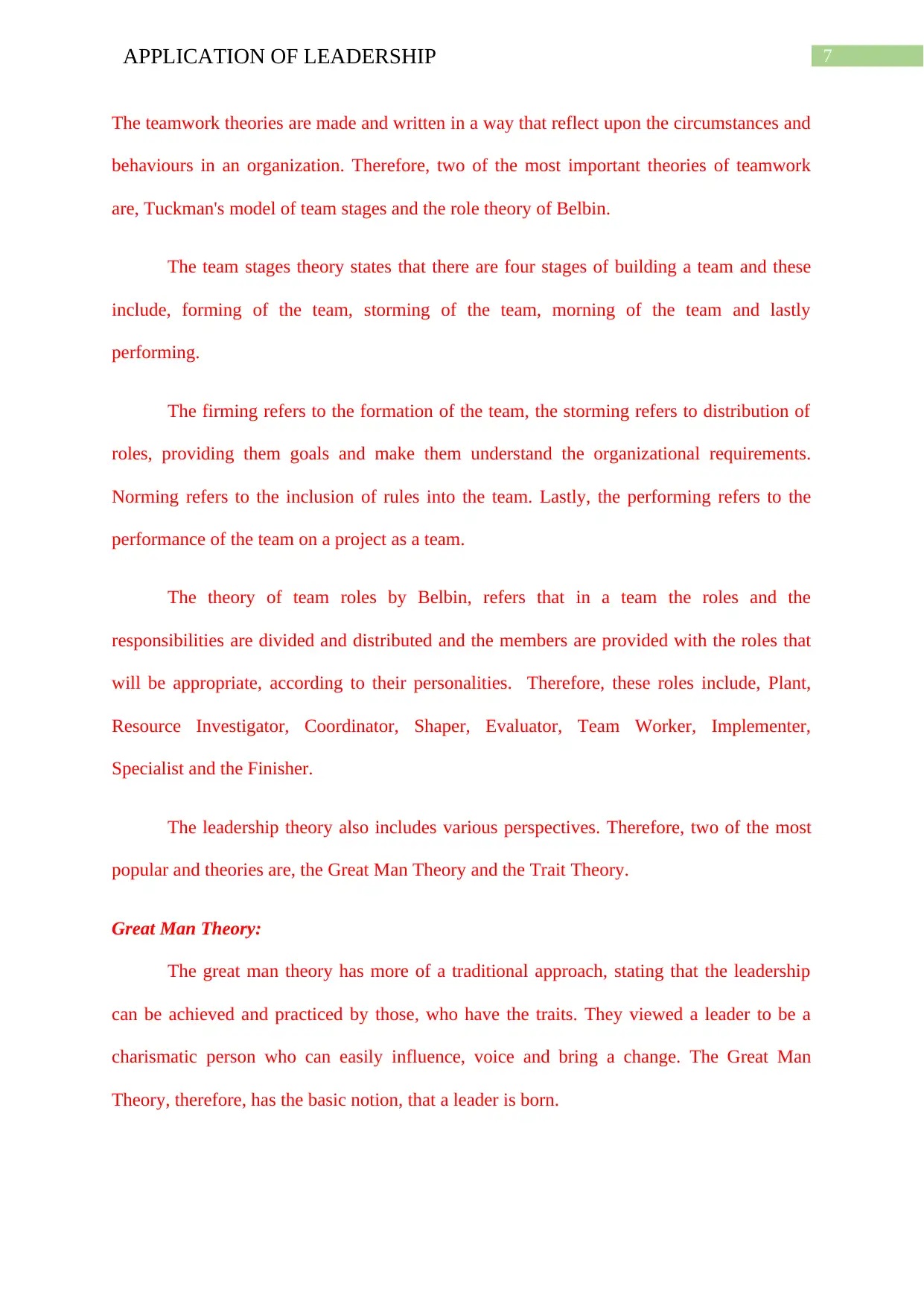
7APPLICATION OF LEADERSHIP
The teamwork theories are made and written in a way that reflect upon the circumstances and
behaviours in an organization. Therefore, two of the most important theories of teamwork
are, Tuckman's model of team stages and the role theory of Belbin.
The team stages theory states that there are four stages of building a team and these
include, forming of the team, storming of the team, morning of the team and lastly
performing.
The firming refers to the formation of the team, the storming refers to distribution of
roles, providing them goals and make them understand the organizational requirements.
Norming refers to the inclusion of rules into the team. Lastly, the performing refers to the
performance of the team on a project as a team.
The theory of team roles by Belbin, refers that in a team the roles and the
responsibilities are divided and distributed and the members are provided with the roles that
will be appropriate, according to their personalities. Therefore, these roles include, Plant,
Resource Investigator, Coordinator, Shaper, Evaluator, Team Worker, Implementer,
Specialist and the Finisher.
The leadership theory also includes various perspectives. Therefore, two of the most
popular and theories are, the Great Man Theory and the Trait Theory.
Great Man Theory:
The great man theory has more of a traditional approach, stating that the leadership
can be achieved and practiced by those, who have the traits. They viewed a leader to be a
charismatic person who can easily influence, voice and bring a change. The Great Man
Theory, therefore, has the basic notion, that a leader is born.
The teamwork theories are made and written in a way that reflect upon the circumstances and
behaviours in an organization. Therefore, two of the most important theories of teamwork
are, Tuckman's model of team stages and the role theory of Belbin.
The team stages theory states that there are four stages of building a team and these
include, forming of the team, storming of the team, morning of the team and lastly
performing.
The firming refers to the formation of the team, the storming refers to distribution of
roles, providing them goals and make them understand the organizational requirements.
Norming refers to the inclusion of rules into the team. Lastly, the performing refers to the
performance of the team on a project as a team.
The theory of team roles by Belbin, refers that in a team the roles and the
responsibilities are divided and distributed and the members are provided with the roles that
will be appropriate, according to their personalities. Therefore, these roles include, Plant,
Resource Investigator, Coordinator, Shaper, Evaluator, Team Worker, Implementer,
Specialist and the Finisher.
The leadership theory also includes various perspectives. Therefore, two of the most
popular and theories are, the Great Man Theory and the Trait Theory.
Great Man Theory:
The great man theory has more of a traditional approach, stating that the leadership
can be achieved and practiced by those, who have the traits. They viewed a leader to be a
charismatic person who can easily influence, voice and bring a change. The Great Man
Theory, therefore, has the basic notion, that a leader is born.
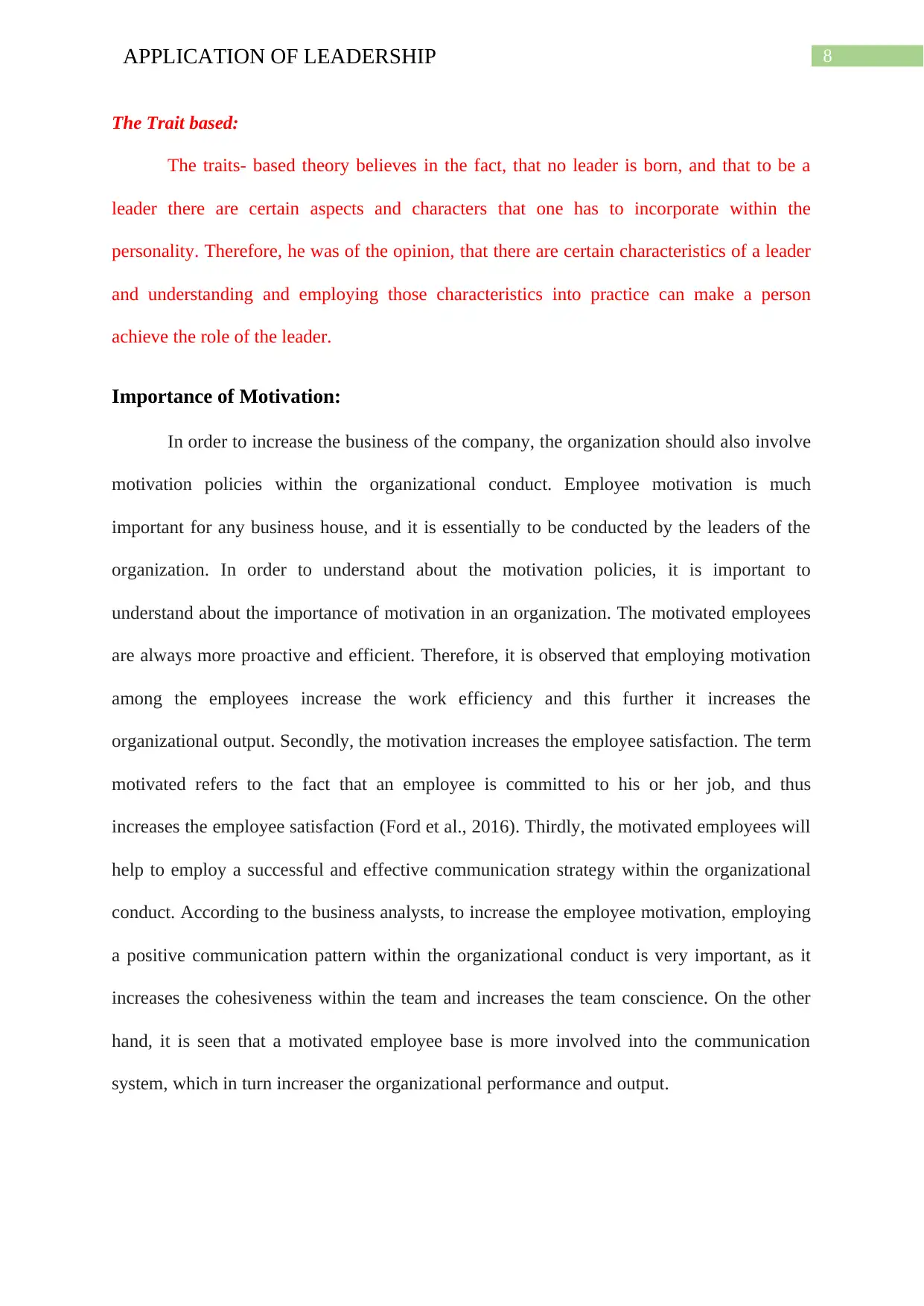
8APPLICATION OF LEADERSHIP
The Trait based:
The traits- based theory believes in the fact, that no leader is born, and that to be a
leader there are certain aspects and characters that one has to incorporate within the
personality. Therefore, he was of the opinion, that there are certain characteristics of a leader
and understanding and employing those characteristics into practice can make a person
achieve the role of the leader.
Importance of Motivation:
In order to increase the business of the company, the organization should also involve
motivation policies within the organizational conduct. Employee motivation is much
important for any business house, and it is essentially to be conducted by the leaders of the
organization. In order to understand about the motivation policies, it is important to
understand about the importance of motivation in an organization. The motivated employees
are always more proactive and efficient. Therefore, it is observed that employing motivation
among the employees increase the work efficiency and this further it increases the
organizational output. Secondly, the motivation increases the employee satisfaction. The term
motivated refers to the fact that an employee is committed to his or her job, and thus
increases the employee satisfaction (Ford et al., 2016). Thirdly, the motivated employees will
help to employ a successful and effective communication strategy within the organizational
conduct. According to the business analysts, to increase the employee motivation, employing
a positive communication pattern within the organizational conduct is very important, as it
increases the cohesiveness within the team and increases the team conscience. On the other
hand, it is seen that a motivated employee base is more involved into the communication
system, which in turn increaser the organizational performance and output.
The Trait based:
The traits- based theory believes in the fact, that no leader is born, and that to be a
leader there are certain aspects and characters that one has to incorporate within the
personality. Therefore, he was of the opinion, that there are certain characteristics of a leader
and understanding and employing those characteristics into practice can make a person
achieve the role of the leader.
Importance of Motivation:
In order to increase the business of the company, the organization should also involve
motivation policies within the organizational conduct. Employee motivation is much
important for any business house, and it is essentially to be conducted by the leaders of the
organization. In order to understand about the motivation policies, it is important to
understand about the importance of motivation in an organization. The motivated employees
are always more proactive and efficient. Therefore, it is observed that employing motivation
among the employees increase the work efficiency and this further it increases the
organizational output. Secondly, the motivation increases the employee satisfaction. The term
motivated refers to the fact that an employee is committed to his or her job, and thus
increases the employee satisfaction (Ford et al., 2016). Thirdly, the motivated employees will
help to employ a successful and effective communication strategy within the organizational
conduct. According to the business analysts, to increase the employee motivation, employing
a positive communication pattern within the organizational conduct is very important, as it
increases the cohesiveness within the team and increases the team conscience. On the other
hand, it is seen that a motivated employee base is more involved into the communication
system, which in turn increaser the organizational performance and output.
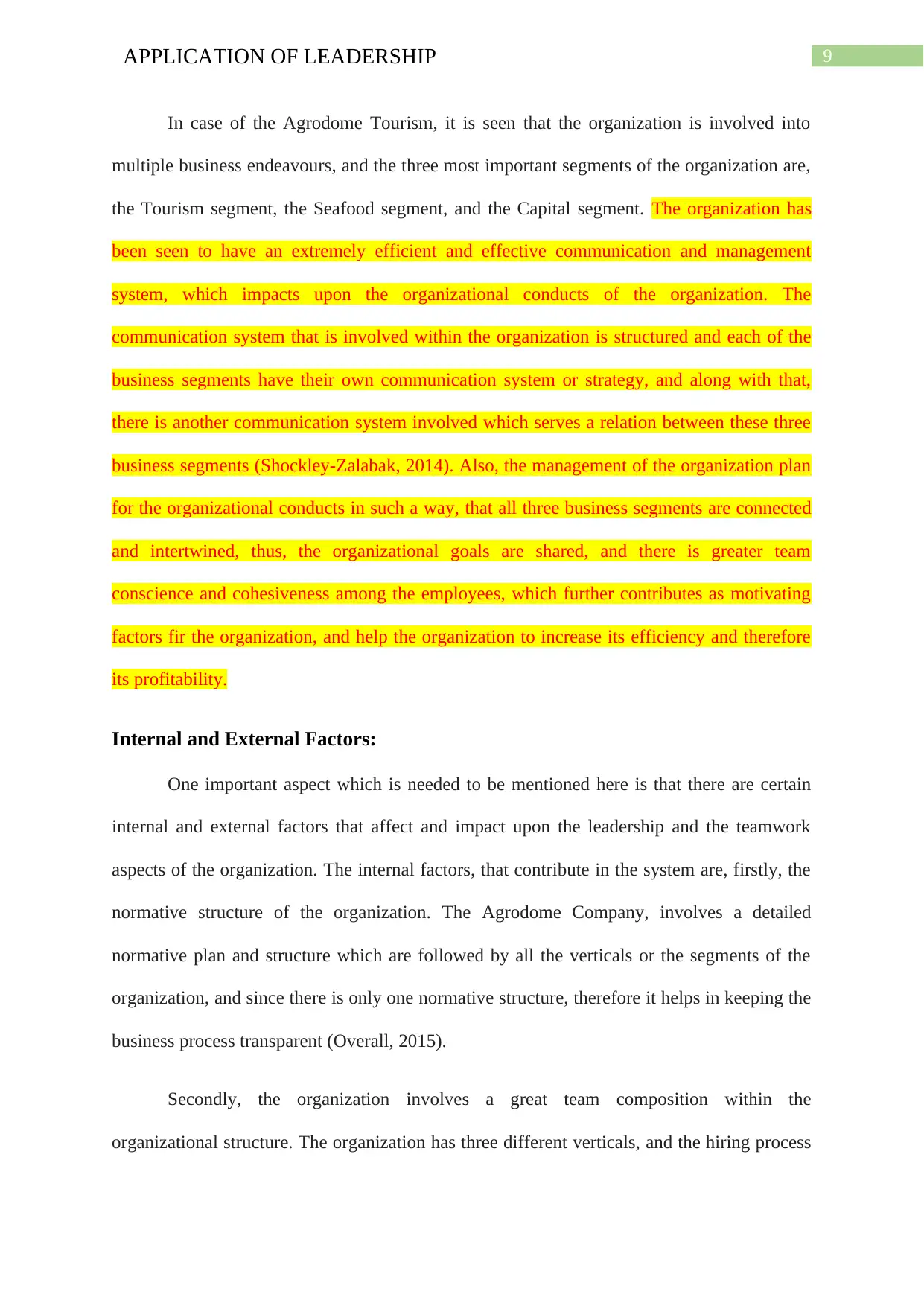
9APPLICATION OF LEADERSHIP
In case of the Agrodome Tourism, it is seen that the organization is involved into
multiple business endeavours, and the three most important segments of the organization are,
the Tourism segment, the Seafood segment, and the Capital segment. The organization has
been seen to have an extremely efficient and effective communication and management
system, which impacts upon the organizational conducts of the organization. The
communication system that is involved within the organization is structured and each of the
business segments have their own communication system or strategy, and along with that,
there is another communication system involved which serves a relation between these three
business segments (Shockley-Zalabak, 2014). Also, the management of the organization plan
for the organizational conducts in such a way, that all three business segments are connected
and intertwined, thus, the organizational goals are shared, and there is greater team
conscience and cohesiveness among the employees, which further contributes as motivating
factors fir the organization, and help the organization to increase its efficiency and therefore
its profitability.
Internal and External Factors:
One important aspect which is needed to be mentioned here is that there are certain
internal and external factors that affect and impact upon the leadership and the teamwork
aspects of the organization. The internal factors, that contribute in the system are, firstly, the
normative structure of the organization. The Agrodome Company, involves a detailed
normative plan and structure which are followed by all the verticals or the segments of the
organization, and since there is only one normative structure, therefore it helps in keeping the
business process transparent (Overall, 2015).
Secondly, the organization involves a great team composition within the
organizational structure. The organization has three different verticals, and the hiring process
In case of the Agrodome Tourism, it is seen that the organization is involved into
multiple business endeavours, and the three most important segments of the organization are,
the Tourism segment, the Seafood segment, and the Capital segment. The organization has
been seen to have an extremely efficient and effective communication and management
system, which impacts upon the organizational conducts of the organization. The
communication system that is involved within the organization is structured and each of the
business segments have their own communication system or strategy, and along with that,
there is another communication system involved which serves a relation between these three
business segments (Shockley-Zalabak, 2014). Also, the management of the organization plan
for the organizational conducts in such a way, that all three business segments are connected
and intertwined, thus, the organizational goals are shared, and there is greater team
conscience and cohesiveness among the employees, which further contributes as motivating
factors fir the organization, and help the organization to increase its efficiency and therefore
its profitability.
Internal and External Factors:
One important aspect which is needed to be mentioned here is that there are certain
internal and external factors that affect and impact upon the leadership and the teamwork
aspects of the organization. The internal factors, that contribute in the system are, firstly, the
normative structure of the organization. The Agrodome Company, involves a detailed
normative plan and structure which are followed by all the verticals or the segments of the
organization, and since there is only one normative structure, therefore it helps in keeping the
business process transparent (Overall, 2015).
Secondly, the organization involves a great team composition within the
organizational structure. The organization has three different verticals, and the hiring process
Secure Best Marks with AI Grader
Need help grading? Try our AI Grader for instant feedback on your assignments.
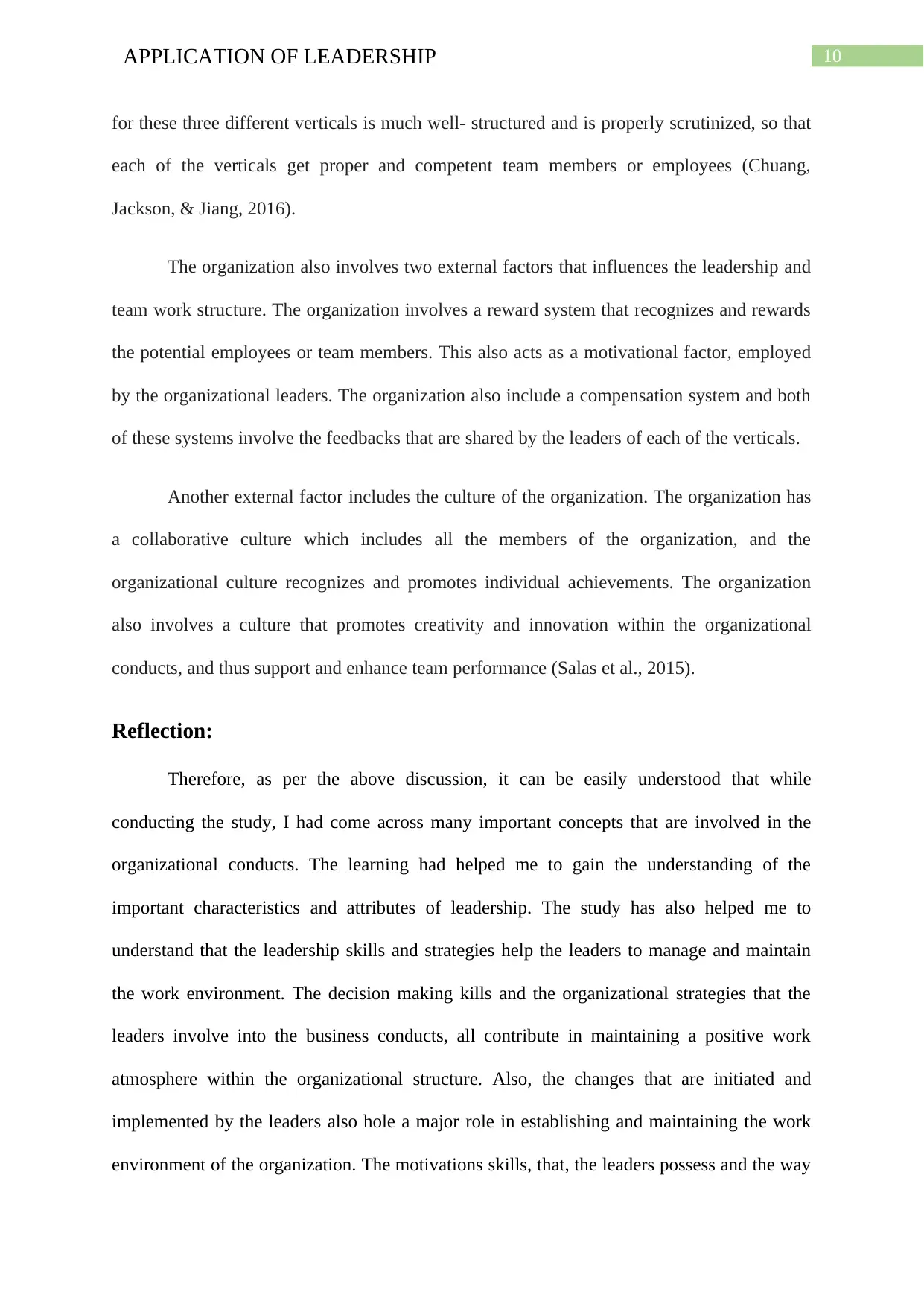
10APPLICATION OF LEADERSHIP
for these three different verticals is much well- structured and is properly scrutinized, so that
each of the verticals get proper and competent team members or employees (Chuang,
Jackson, & Jiang, 2016).
The organization also involves two external factors that influences the leadership and
team work structure. The organization involves a reward system that recognizes and rewards
the potential employees or team members. This also acts as a motivational factor, employed
by the organizational leaders. The organization also include a compensation system and both
of these systems involve the feedbacks that are shared by the leaders of each of the verticals.
Another external factor includes the culture of the organization. The organization has
a collaborative culture which includes all the members of the organization, and the
organizational culture recognizes and promotes individual achievements. The organization
also involves a culture that promotes creativity and innovation within the organizational
conducts, and thus support and enhance team performance (Salas et al., 2015).
Reflection:
Therefore, as per the above discussion, it can be easily understood that while
conducting the study, I had come across many important concepts that are involved in the
organizational conducts. The learning had helped me to gain the understanding of the
important characteristics and attributes of leadership. The study has also helped me to
understand that the leadership skills and strategies help the leaders to manage and maintain
the work environment. The decision making kills and the organizational strategies that the
leaders involve into the business conducts, all contribute in maintaining a positive work
atmosphere within the organizational structure. Also, the changes that are initiated and
implemented by the leaders also hole a major role in establishing and maintaining the work
environment of the organization. The motivations skills, that, the leaders possess and the way
for these three different verticals is much well- structured and is properly scrutinized, so that
each of the verticals get proper and competent team members or employees (Chuang,
Jackson, & Jiang, 2016).
The organization also involves two external factors that influences the leadership and
team work structure. The organization involves a reward system that recognizes and rewards
the potential employees or team members. This also acts as a motivational factor, employed
by the organizational leaders. The organization also include a compensation system and both
of these systems involve the feedbacks that are shared by the leaders of each of the verticals.
Another external factor includes the culture of the organization. The organization has
a collaborative culture which includes all the members of the organization, and the
organizational culture recognizes and promotes individual achievements. The organization
also involves a culture that promotes creativity and innovation within the organizational
conducts, and thus support and enhance team performance (Salas et al., 2015).
Reflection:
Therefore, as per the above discussion, it can be easily understood that while
conducting the study, I had come across many important concepts that are involved in the
organizational conducts. The learning had helped me to gain the understanding of the
important characteristics and attributes of leadership. The study has also helped me to
understand that the leadership skills and strategies help the leaders to manage and maintain
the work environment. The decision making kills and the organizational strategies that the
leaders involve into the business conducts, all contribute in maintaining a positive work
atmosphere within the organizational structure. Also, the changes that are initiated and
implemented by the leaders also hole a major role in establishing and maintaining the work
environment of the organization. The motivations skills, that, the leaders possess and the way
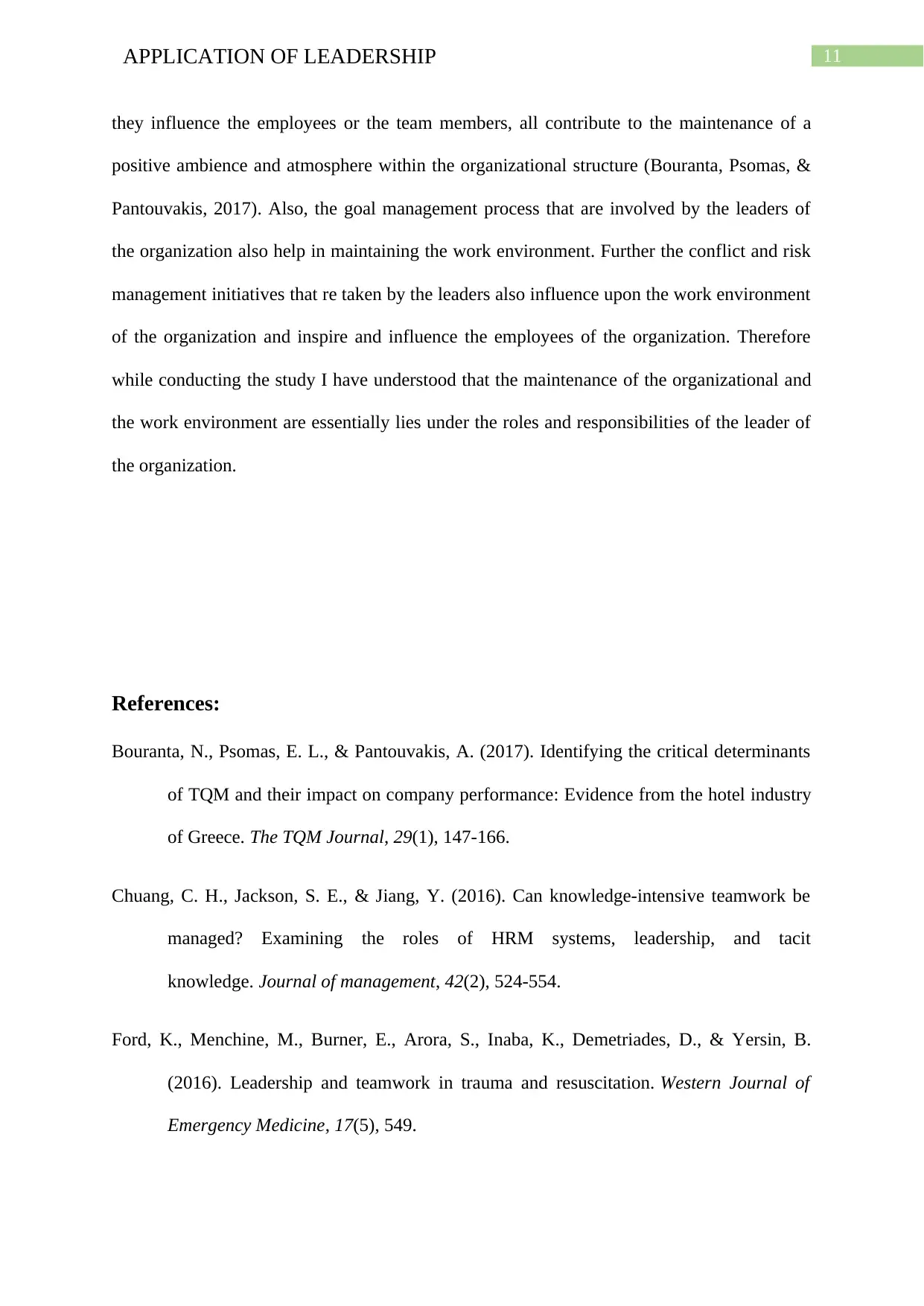
11APPLICATION OF LEADERSHIP
they influence the employees or the team members, all contribute to the maintenance of a
positive ambience and atmosphere within the organizational structure (Bouranta, Psomas, &
Pantouvakis, 2017). Also, the goal management process that are involved by the leaders of
the organization also help in maintaining the work environment. Further the conflict and risk
management initiatives that re taken by the leaders also influence upon the work environment
of the organization and inspire and influence the employees of the organization. Therefore
while conducting the study I have understood that the maintenance of the organizational and
the work environment are essentially lies under the roles and responsibilities of the leader of
the organization.
References:
Bouranta, N., Psomas, E. L., & Pantouvakis, A. (2017). Identifying the critical determinants
of TQM and their impact on company performance: Evidence from the hotel industry
of Greece. The TQM Journal, 29(1), 147-166.
Chuang, C. H., Jackson, S. E., & Jiang, Y. (2016). Can knowledge-intensive teamwork be
managed? Examining the roles of HRM systems, leadership, and tacit
knowledge. Journal of management, 42(2), 524-554.
Ford, K., Menchine, M., Burner, E., Arora, S., Inaba, K., Demetriades, D., & Yersin, B.
(2016). Leadership and teamwork in trauma and resuscitation. Western Journal of
Emergency Medicine, 17(5), 549.
they influence the employees or the team members, all contribute to the maintenance of a
positive ambience and atmosphere within the organizational structure (Bouranta, Psomas, &
Pantouvakis, 2017). Also, the goal management process that are involved by the leaders of
the organization also help in maintaining the work environment. Further the conflict and risk
management initiatives that re taken by the leaders also influence upon the work environment
of the organization and inspire and influence the employees of the organization. Therefore
while conducting the study I have understood that the maintenance of the organizational and
the work environment are essentially lies under the roles and responsibilities of the leader of
the organization.
References:
Bouranta, N., Psomas, E. L., & Pantouvakis, A. (2017). Identifying the critical determinants
of TQM and their impact on company performance: Evidence from the hotel industry
of Greece. The TQM Journal, 29(1), 147-166.
Chuang, C. H., Jackson, S. E., & Jiang, Y. (2016). Can knowledge-intensive teamwork be
managed? Examining the roles of HRM systems, leadership, and tacit
knowledge. Journal of management, 42(2), 524-554.
Ford, K., Menchine, M., Burner, E., Arora, S., Inaba, K., Demetriades, D., & Yersin, B.
(2016). Leadership and teamwork in trauma and resuscitation. Western Journal of
Emergency Medicine, 17(5), 549.
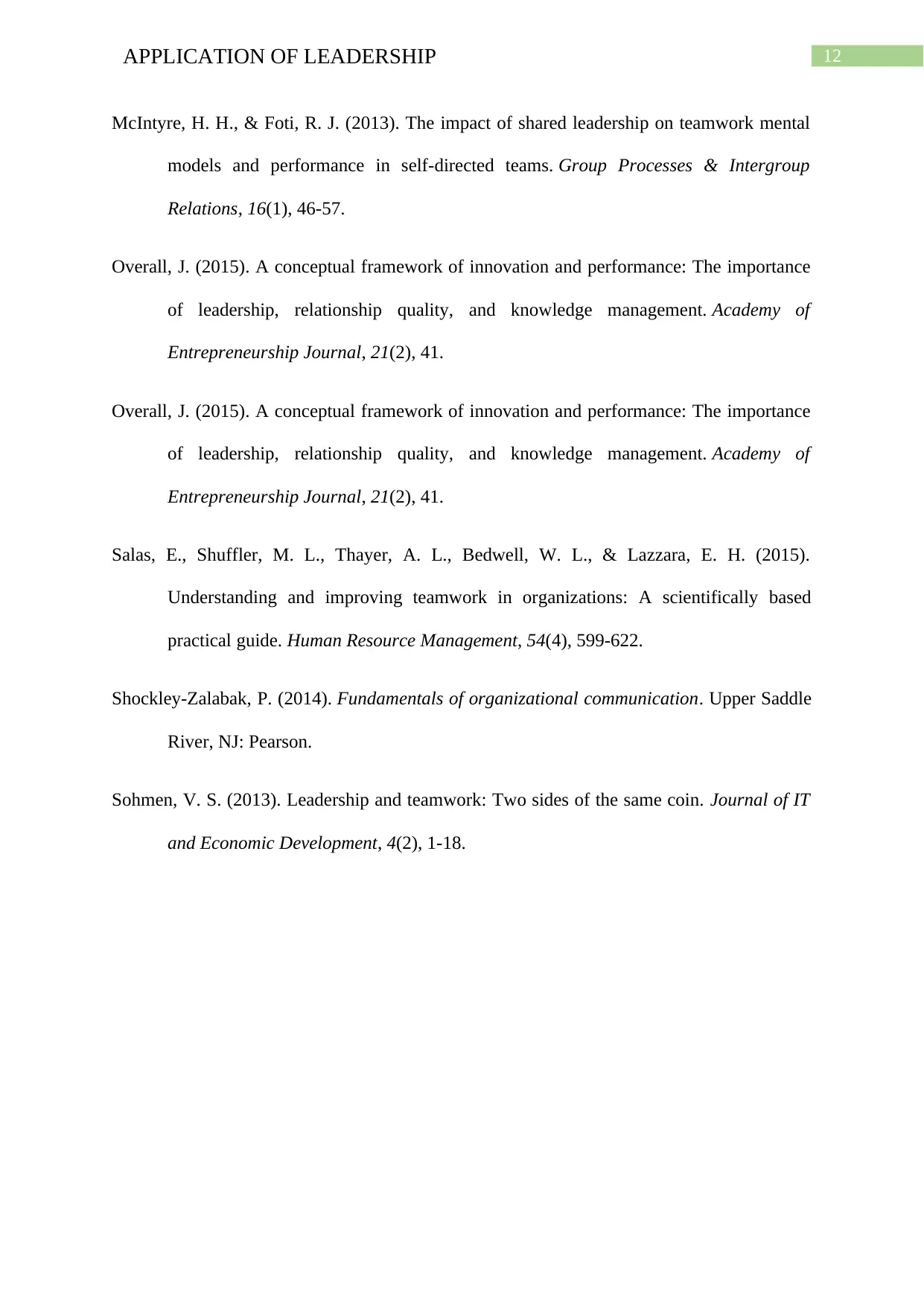
12APPLICATION OF LEADERSHIP
McIntyre, H. H., & Foti, R. J. (2013). The impact of shared leadership on teamwork mental
models and performance in self-directed teams. Group Processes & Intergroup
Relations, 16(1), 46-57.
Overall, J. (2015). A conceptual framework of innovation and performance: The importance
of leadership, relationship quality, and knowledge management. Academy of
Entrepreneurship Journal, 21(2), 41.
Overall, J. (2015). A conceptual framework of innovation and performance: The importance
of leadership, relationship quality, and knowledge management. Academy of
Entrepreneurship Journal, 21(2), 41.
Salas, E., Shuffler, M. L., Thayer, A. L., Bedwell, W. L., & Lazzara, E. H. (2015).
Understanding and improving teamwork in organizations: A scientifically based
practical guide. Human Resource Management, 54(4), 599-622.
Shockley-Zalabak, P. (2014). Fundamentals of organizational communication. Upper Saddle
River, NJ: Pearson.
Sohmen, V. S. (2013). Leadership and teamwork: Two sides of the same coin. Journal of IT
and Economic Development, 4(2), 1-18.
McIntyre, H. H., & Foti, R. J. (2013). The impact of shared leadership on teamwork mental
models and performance in self-directed teams. Group Processes & Intergroup
Relations, 16(1), 46-57.
Overall, J. (2015). A conceptual framework of innovation and performance: The importance
of leadership, relationship quality, and knowledge management. Academy of
Entrepreneurship Journal, 21(2), 41.
Overall, J. (2015). A conceptual framework of innovation and performance: The importance
of leadership, relationship quality, and knowledge management. Academy of
Entrepreneurship Journal, 21(2), 41.
Salas, E., Shuffler, M. L., Thayer, A. L., Bedwell, W. L., & Lazzara, E. H. (2015).
Understanding and improving teamwork in organizations: A scientifically based
practical guide. Human Resource Management, 54(4), 599-622.
Shockley-Zalabak, P. (2014). Fundamentals of organizational communication. Upper Saddle
River, NJ: Pearson.
Sohmen, V. S. (2013). Leadership and teamwork: Two sides of the same coin. Journal of IT
and Economic Development, 4(2), 1-18.
1 out of 13
Related Documents
Your All-in-One AI-Powered Toolkit for Academic Success.
+13062052269
info@desklib.com
Available 24*7 on WhatsApp / Email
![[object Object]](/_next/static/media/star-bottom.7253800d.svg)
Unlock your academic potential
© 2024 | Zucol Services PVT LTD | All rights reserved.





